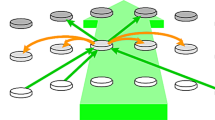Abstract.
We present further simulation results of the model of two reciprocally connected visual areas proposed in the first paper [Knoblauch and Palm (2002) Biol Cybern 87:151–167]. One area corresponds to the orientation–selective subsystem of the primary visual cortex, the other is modeled as an associative memory representing stimulus objects according to Hebbian learning. We examine the scene-segmentation capability of our model on larger time and space scales, and relate it to experimental findings. Scene segmentation is achieved by attention switching on a time-scale longer than the gamma range. We find that the time-scale can vary depending on habituation parameters in the range of tens to hundreds of milliseconds. The switching process can be related to findings concerning attention and biased competition, and we reproduce experimental poststimulus time histograms (PSTHs) of single neurons under different stimulus and attentional conditions. In a larger variant the model exhibits traveling waves of activity on both slow and fast time-scales, with properties similar to those found in experiments. An apparent weakness of our standard model is the tendency to produce anti-phase correlations for fast activity from the two areas. Increasing the inter-areal delays in our model produces alternations of in-phase and anti-phase oscillations. The experimentally observed in-phase correlations can most naturally be obtained by the involvement of both fast and slow inter-areal connections; e.g., by two axon populations corresponding to fast-conducting myelinated and slow-conducting unmyelinated axons.
Similar content being viewed by others
Author information
Authors and Affiliations
Additional information
Received: 22 August 2001 / Accepted in revised form: 8 April 2002
Rights and permissions
About this article
Cite this article
Knoblauch, A., Palm, G. Scene segmentation by spike synchronization in reciprocally connected visual areas. II. Global assemblies and synchronization on larger space and time scales. Biol Cybern 87, 168–184 (2002). https://doi.org/10.1007/s00422-002-0332-3
Issue Date:
DOI: https://doi.org/10.1007/s00422-002-0332-3




